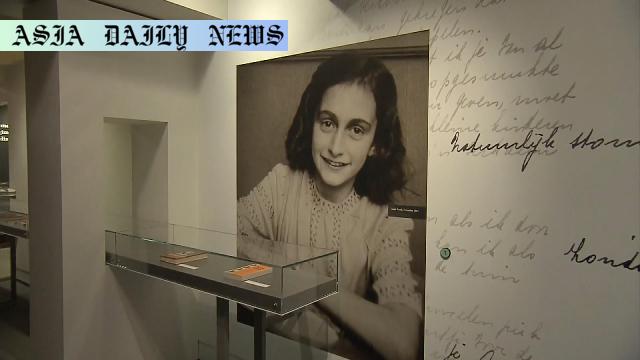Anne Frank: A full-scale replica of the secret annex where Anne Frank wrote her diary is on display in New York City.
- The exhibition features a full-scale replica of Anne Frank’s secret annex.
- It commemorates the 80th anniversary of Auschwitz’s liberation.
- The aim is to educate visitors, especially young people, about history.
- The exhibit is a meaningful reminder to never forget the past.

Introduction: A Tribute to Anne Frank in New York
A full-scale replica of the secret annex where Anne Frank lived and wrote her world-famous diary has opened in New York City, marking a significant moment in the remembrance of history. This special exhibition coincides with the 80th anniversary of the liberation of Auschwitz, emphasizing the importance of preserving stories of resilience and courage in the face of atrocities. The exhibit is designed to educate and inspire individuals of all ages by bringing to life the space where Anne Frank and her family sought refuge from Nazi persecution.
The Historical Significance of the Secret Annex
The secret annex, concealed behind a revolving bookcase, became synonymous with Anne Frank’s story and the human cost of the Holocaust. Hidden for approximately two years, Anne’s family and four others lived in this confined space with limited resources. The young Anne chronicled their experiences in her diary, which later became a global symbol of hope, resilience, and the personal toll of persecution. This replica annex, furnished with items crafted to replicate the originals, creates an immersive experience for visitors, allowing them to connect on a deeper level with the history it represents.
Anne Frank’s Legacy in Today’s World
Anne Frank remains one of the most compelling voices of the 20th century. Her diary, published as “The Diary of a Young Girl,” has been translated into dozens of languages, reminding millions of the brutal realities of the Holocaust. This exhibit not only highlights her life but also serves as a platform to educate future generations on the hazards of hatred, discrimination, and silence in the face of injustice. In light of present global challenges, this exhibition is especially poignant for today’s youth, Tom Holman, one of its curators, noted.
Visitor Experiences and Reactions
The exhibit has evoked powerful emotional responses among visitors, including those with personal connections to Holocaust survivors. For instance, a Jewish woman shared how her grandparents fled Germany during World War II, calling the exhibit a compelling reminder to “never forget.” Visitors explore the carefully recreated space to witness firsthand the conditions faced by Anne Frank’s family. Many expressed how the exhibit fosters empathy and a stronger resolve to fight prejudice in today’s world.
A Call to Action for Younger Generations
Ronald Leopold, the Executive Director of the Anne Frank House, emphasized the importance of young people visiting the exhibition. He has expressed hopes that the exhibit will promote a global dialogue about tolerance and understanding that transcends borders and cultures. By connecting with Anne Frank’s story, younger generations can better understand the relevance of historical lessons in confronting modern threats to freedom and human rights.
Looking Back to Look Forward
This exhibit goes beyond just historical retelling—it challenges visitors to reflect. The replica annex underscores how systemic hatred devastated so many lives and implores contemporary society to combat modern iterations of such dangers. Living in a divided world, the exhibition’s timing cannot be overstated: it impels individuals to introspect and take collective action to protect human dignity.
Conclusion: Preserving Memory, Educating Future Generations
The full-scale replica of Anne Frank’s annex serves not only as a solemn remembrance of the past but also as a crucial educational tool for the present and future. By invoking empathy and understanding, the exhibit continues Anne Frank’s legacy of inspiring global conversations about humanity’s responsibility to fight hatred and uphold justice. As visitors leave the exhibit, they carry with them a renewed awareness of their role in ensuring history does not repeat itself, as well as hope for a world united in peace and tolerance.



Commentary
The Profound Impact of Anne Frank’s Story
Anne Frank’s diary has transcended its context in the Holocaust to become a universal narrative of resilience and hope. Her voice, frozen in her teenage years, resonates as a powerful testimony to the human spirit’s endurance against unimaginable suffering. Creating a full-scale replica of her annex brings her story to life in a way that text alone cannot. By stepping into a tangible representation of where Anne lived her final two years in hiding, visitors forge a deep, personal connection to a chapter of history that must never fade into obscurity.
The Timeless Relevance of This Exhibition
What makes this exhibit important isn’t merely its historical significance, but its relevance in today’s challenging global environment. We see echoes of the divisiveness and bigotry that marked Anne Frank’s era in current events, from rising antisemitism to discrimination against other vulnerable groups. Anne’s story carries a universal message: the importance of compassion, courage, and standing up against hatred in all its forms. This exhibition serves as a catalyst for these critical conversations, reminding us of the fragility of societal progress.
A Moving Educational Opportunity
One of the most uplifting elements of this exhibition is its mission to educate young people, the leaders of tomorrow. Providing a space for them to learn, reflect, and understand the impacts of historical atrocities equips them with insight necessary to build a more inclusive future. Engaging educational efforts like these ensure that Anne Frank’s legacy continues to inspire new generations while serving as a stark warning against allowing history to repeat itself. This exhibition in New York isn’t just a tribute—it is a call to action for all of humanity.